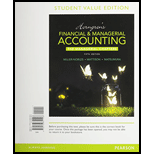
1.
Time value of money: Any amount invested today earns an additional income, called interest income, after a certain period. This is called as time value of money.
Present Value: The value of today’s amount expected to be paid or received in the future at a compound interest rate is called as present value.
To calculate: The amount (present value) that company receives upon the issuance of the bonds payable.
2.
Effective-interest amortization method: Effective-interest amortization method it is an amortization model that apportions the amount of bond discount or premium based on the market interest rate.
In this method, first, interest expense is calculated based on the current carrying amount and market interest rate and cash interest payment is calculated based on the face value amount and stated interest rate and then, the different between the cash interest payment and interest expense is amortized as a decrease to the discount or premium.
Amortization Schedule: An amortization schedule is a table that shows the details of each loan payment allocated between the principal amount and the overdue interest along with the beginning and ending balance of the loan. From the amortization schedule of the loan, the periodical interest expense, total interest expense and total payment made are known.
To prepare: An amortization table using the effective interest amortization method for the first two semiannual interest periods.
3.
To Journalize: Issuance of the bonds on January 1, 2016.
Want to see the full answer?
Check out a sample textbook solution
Chapter 12 Solutions
Horngren's Financial & Managerial Accounting, The Managerial Chapters, Student Value Edition (5th Edition)
- General Accounting Questionarrow_forwardNewcombe & Associates, Inc. is considering the introduction of a new product. Production of the new product requires an investment of $140,000 in equipment that has a five-year life. The equipment has no salvage value at the end of five years and will be depreciated on a straight-line basis. Newcombe's required return is 15%, and the tax rate is 34%. The firm has made the following forecasts: Base Case Lower Bound Upper Bound Unit Sales 2,000 1,800 2,200 Price Per Unit $55 $50 $60 Variable Costs Per Unit $22 $21 $23 Fixed Costs Per Year $10,000 $9,500 $10,500 Suppose that sales for the project under consideration by Newcombe increases from 2,000 units to 2,200 units per year. Compute the DOL for the project at sales of 2,000 units. Use both the definition of the DOL and its algebraic equivalent. Assume Newcome pays no taxes on this project. Show all workarrow_forwardCalculate the debt Equity ?arrow_forward
- Please provide correct answerarrow_forwardSolve this Accounting Problemarrow_forwardDeltaTech uses the straight-line method. Assets purchased between the 1st and 15th of the month are depreciated for the entire month; assets purchased after the 15th of the month are treated as though they were acquired the following month. On September 18, 20X3, DeltaTech purchases a scanner for $12,000, which it expects to last for 6 years. DeltaTech expects the scanner to have a residual value of $3,000. What is the 20X4 depreciation expense for the scanner? Need helparrow_forward
- Principles of Accounting Volume 1AccountingISBN:9781947172685Author:OpenStaxPublisher:OpenStax College
 Financial AccountingAccountingISBN:9781305088436Author:Carl Warren, Jim Reeve, Jonathan DuchacPublisher:Cengage Learning
Financial AccountingAccountingISBN:9781305088436Author:Carl Warren, Jim Reeve, Jonathan DuchacPublisher:Cengage Learning Cornerstones of Financial AccountingAccountingISBN:9781337690881Author:Jay Rich, Jeff JonesPublisher:Cengage Learning
Cornerstones of Financial AccountingAccountingISBN:9781337690881Author:Jay Rich, Jeff JonesPublisher:Cengage Learning  Financial Accounting: The Impact on Decision Make...AccountingISBN:9781305654174Author:Gary A. Porter, Curtis L. NortonPublisher:Cengage Learning
Financial Accounting: The Impact on Decision Make...AccountingISBN:9781305654174Author:Gary A. Porter, Curtis L. NortonPublisher:Cengage Learning Excel Applications for Accounting PrinciplesAccountingISBN:9781111581565Author:Gaylord N. SmithPublisher:Cengage Learning
Excel Applications for Accounting PrinciplesAccountingISBN:9781111581565Author:Gaylord N. SmithPublisher:Cengage Learning Intermediate Accounting: Reporting And AnalysisAccountingISBN:9781337788281Author:James M. Wahlen, Jefferson P. Jones, Donald PagachPublisher:Cengage Learning
Intermediate Accounting: Reporting And AnalysisAccountingISBN:9781337788281Author:James M. Wahlen, Jefferson P. Jones, Donald PagachPublisher:Cengage Learning





